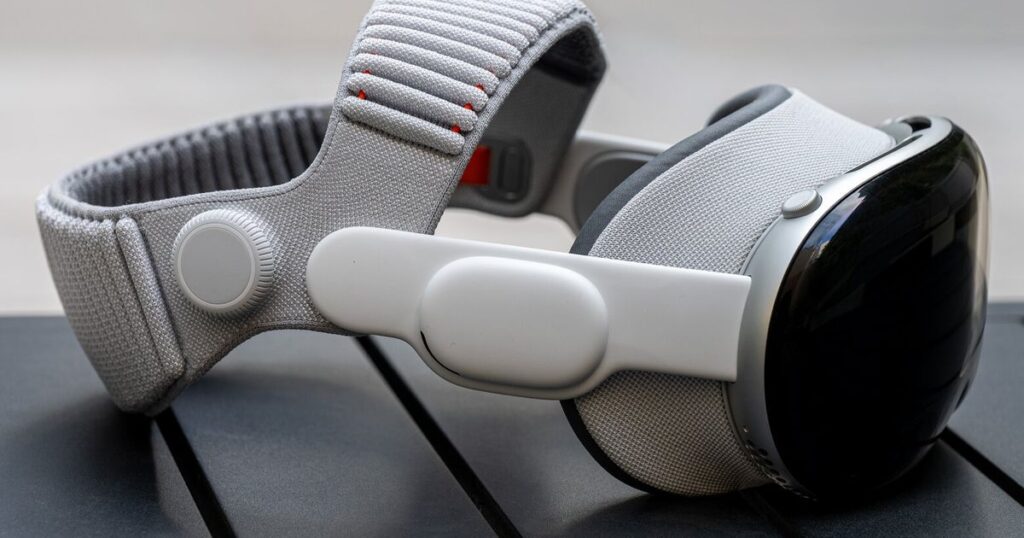When Apple released the Vision Pro last year, the headset had three main drawbacks: a $3,499 starting price, an uncomfortable design and a limited selection of content.
With the debut of a new version with an M5 chip, Apple hasn’t lowered the price or added much additional content. But it has addressed the comfort issue — without changing the hardware itself — thanks to a new head strap called the Dual Knit Band.
The strap is included with all new Vision Pro units, and existing owners can buy one for $99. That means there’s little reason for current Vision Pro users to upgrade to the latest model, since the processor is only slightly faster in real-world use.
The new strap features thick, adjustable padding for both the back and top of the head. The default strap on the first Vision Pro only supported the back, though an optional Dual Loop Band used thin Velcro straps that offered limited support on both the top and back.
Neither of the original offerings worked well. Many users reported pressure and pain on the front of the face, forehead, neck or back of the head — sometimes within minutes of putting the headset on. It’s surprising that Apple spent eight years developing the device but didn’t fully understand or resolve the comfort concerns before launch.
When you pick up the new band for the first time, it feels heavier than the original straps — thanks to the added cushioning and metal inserts in the back that act as counterweights. But once you actually put it on, the headset feels noticeably lighter on your head.
I was able to use the Vision Pro for more than an hour with the new band without noticeable pain or discomfort. From that standpoint, it’s a no-brainer upgrade if you’ve already invested in the headset.
The strap also allows for more precise tightening of both the top and back sections, which improves the overall fit. In my usage, that resulted in more accurate placement over my eyes, enhancing the system’s ability to determine where my pupils are pointing.
That makes the eye-tracking interface more effective. With the prior band, I often found the system selecting the wrong option — or nothing at all.
Adjusting the back of the head is done via a dial — identical to last year’s Solo Knit band — while the top section is adjusted by pulling the same dial out, like a watch crown, and pushing it back in when you’re done.
Based on my testing, Apple has mitigated the Vision Pro weight problem, allowing users to wear the device long enough to get some work done or watch a decent amount of video.
That said, this band doesn’t make the headset comfortable enough for a full workday — not that most users would want to wear it that long anyway. Still, overall, it’s a major improvement.
Until now, Vision Pro users had to seek out third-party straps to make the device more wearable.
One popular aftermarket fix was a rigid plastic frame called the Annapro. Another, from Apple’s go-to accessory partner Belkin, offered a flexible fabric band that sat on top of the wearer’s head. A maker of sleep-apnea headgear even got involved: Resmed Inc. offered a counterweighted, heavily cushioned setup for the Vision Pro — with mixed results.
It was an unfortunate situation for a $3,499 product to require third-party intervention to be usable. And it makes Apple’s new marketing language all the more telling. The company now promotes the Vision Pro as shipping with a “comfortable band” — an acknowledgment that the first version was anything but.
For many early adopters, the only real comfort solution for the device was using it lying down on a couch or bed. That’s hardly the approach Apple showed in its marketing materials, though Chief Executive Officer Tim Cook has said he’s used the Vision Pro that way.
Will the new strap get more consumers to buy the Vision Pro? That’s unlikely. The price remains a barrier to entry, and third-party developers are now concentrating more on business applications for the headset. Apple itself has refocused on smart glasses and recently shelved a cheaper, lighter “Vision Air” model that had been planned for 2027.
Some employees at Apple retail stores say they’re lucky to see a Vision Pro sale more than once a month — making it by far the company’s slowest-selling major product. On launch day, the new model did little to change that. Multiple stores reported that zero Vision Pro demos were scheduled for the debut.
Still, owners of the original Vision Pro appear eager to buy the new strap. On Apple’s online store, there have been some shipping delays for the item, suggesting there’s been a wave of orders for the strap.
— With assistance from Chris Welch
More stories like this are available on bloomberg.com

